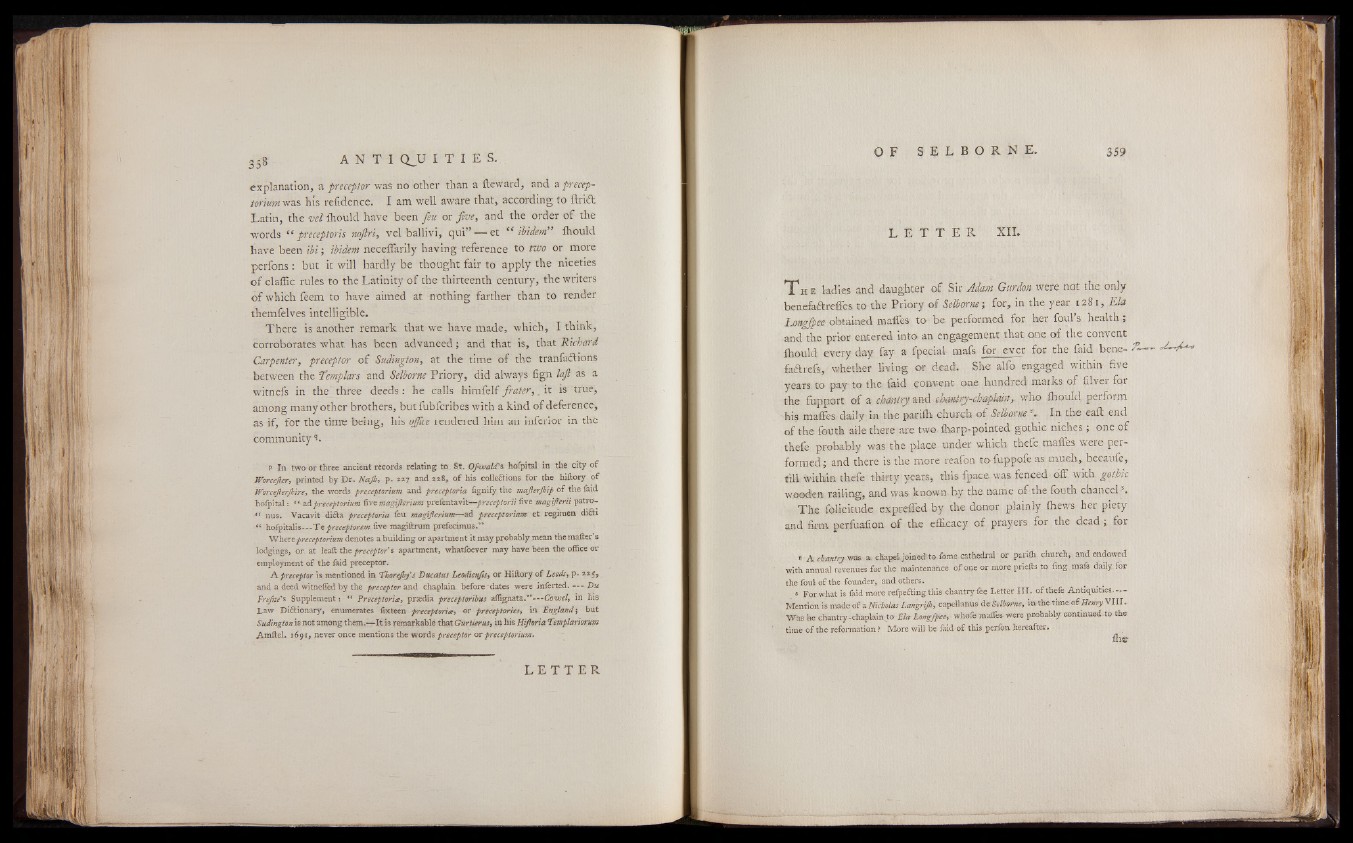
explanation, a preceptor was no other than a {toward, and a precep-
torium was his residence. I am well aware that, according to ftri<5t
Latin, the vel ihould have been feu or five, and the order of the
words ee preceptoris nojiri, vel ballivi, cjui” — et ibidem ihould
have been ibi; ibidem neceffarily having reference to two or more
perfons: but it will hardly be thought fair to apply the niceties
of claffic rules to the Latinity of the thirteenth century, the writers
of which feem to have aimed at nothing farther than to render
themfelves intelligible.
There is another remark that we have made, which, I think,
corroborates what has been advanced; and that is, that Richard
Carpenter, preceptor of Sudington, at the time of the tranfa&ions
between the Templars and Selborne Priory, did always fign baft as a
witnefs in the three deeds: he calls himfelf frater, f it is true,
among many other brothers, but fubfcribes with a kind of deference,
as if, for the time being, his office rendered him an inferior in thé
community
p In two or three ancient records relating to St. Oswald's hofpital in the city o f
Worcefter, printed by Dr. Najb, p. 227 and 228, o f his collections for the hiftory o f
Worcejlerjkire, the words preeeptorium and preceptoria fignify the majlerjbip o f the faid
hofpital: et adpreeeptorium five magijterium prefentavit— preceptorii five magifterii patro-
fi nus. Vacavit dicta preceptoria leu magifterium— ad preceptoriam et regimen dióti
“ hofpitalis-—T e preceptorem five magiftrum prefecknus.”
Where preeeptorium denotes a building or apartment it may probably mean the mailer's
lodgings, or at leaft the preceptors apartment, whatsoever may have been the office or
employment o f the faid preceptor.
A. preceptor is mentioned in ’Fhorejby's Ducatus Leodienfis, or Hiftory o f Leeds, p. 225»
and a deed witnefled b y the preceptor and chaplain before 'dates were inferted. — Du
Frejne's Supplement: “ Preceptoria, praedia preceptoribus affignata.” — Cowel, m his
Law Dictionary, enumerates fixteen preceptoria, or preceptories, in Englandj but
Sudington is not among them.— I t is remarkable that Gurtlerus, in his Hiftoria 'templariorum
Amltel. 1691, never once mentions the words preceptor ox preeeptorium.
L E T T E R
L E T T E R XII.
T h e ladies and daughter of Sir Adam Gurdon were not the only
benefaftreffes to the Priory of Selborne-, for, in the year 1281, E h
Ijmgfyee obtained maffes to be performed for her fpul’s health;
and the prior entered into an engagement that one of the convent
Ihould every day fay a fpecial mafs for ever for the faid bene- A -jU ,
faftrefi, whether living or dead. She alfo engaged within five
years to pay to the laid convent one hundred marks of filvet for
the fupport of a chrntry and chmtry-chajddn, who Ihould perform
his maffes daily in the parifli church of Selborner. In the eafl: end
of the fcuth aile there are two Iharp-pointed gothic niches ; one of
thefe probably was the place under which thefe maffes were performed;
and there is the more reafon to fuppofe as much, beeaufe,
till within thefe thirty years, this fpace. was fenced off with, gothic
wooden railing, and was known by the name of'the fouth chancel f.
The folicitude expreffed by the donor plainly (hews her piety
and firm perfualion of the efficacy of prayers for the dead ; for
n A chantry was a. chapel joined to feme-cathedral or parifli church, and endowed
with annual revenues for the maintenance o f one or more priefts to ling mafs daily, for
the foul o f the founder, and others.
s For what is faid more refpeCling this chantry fee Letter I I I . o f thefe Antiquities.
Mention is made o f a Nicholas Langrijb, eapellanus de Selborne, in<the time o f Henry V III.
Was lie chantry-chaplain jto Elcr Longfpee, whole mafies- were probably continued to the
time o f the reformation ? More will be faid of this perfon. hereafter.
£h&